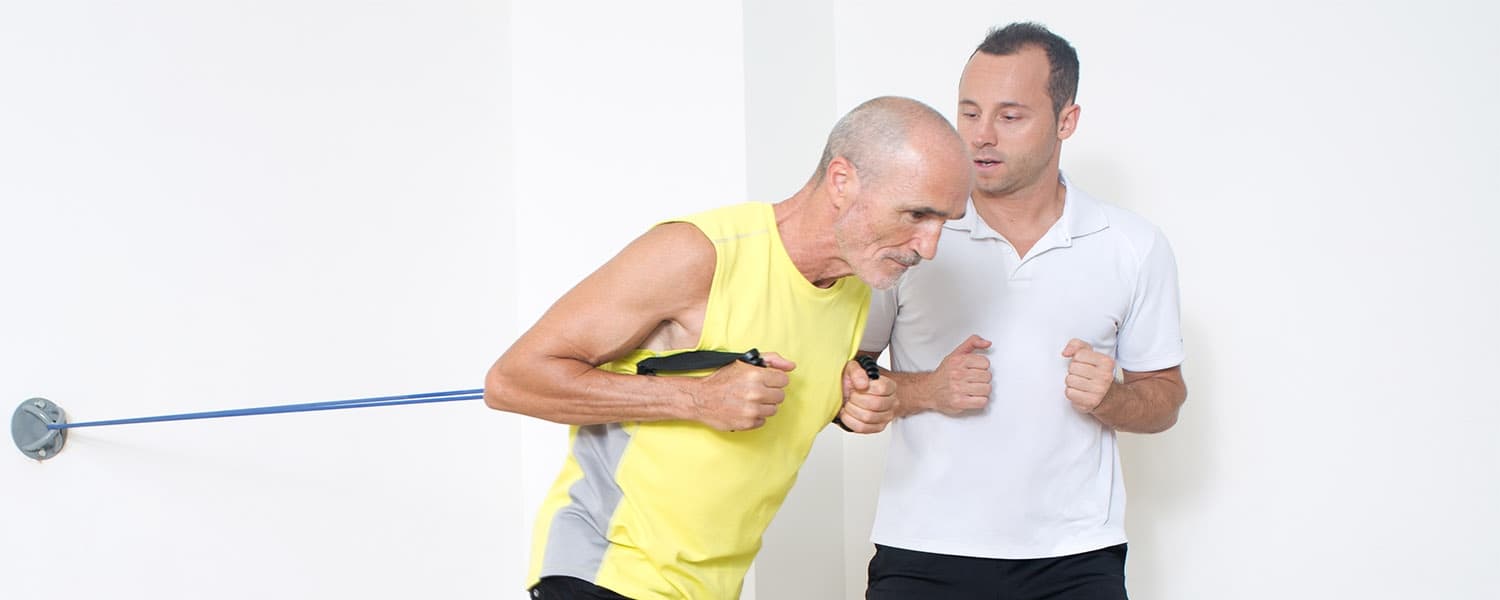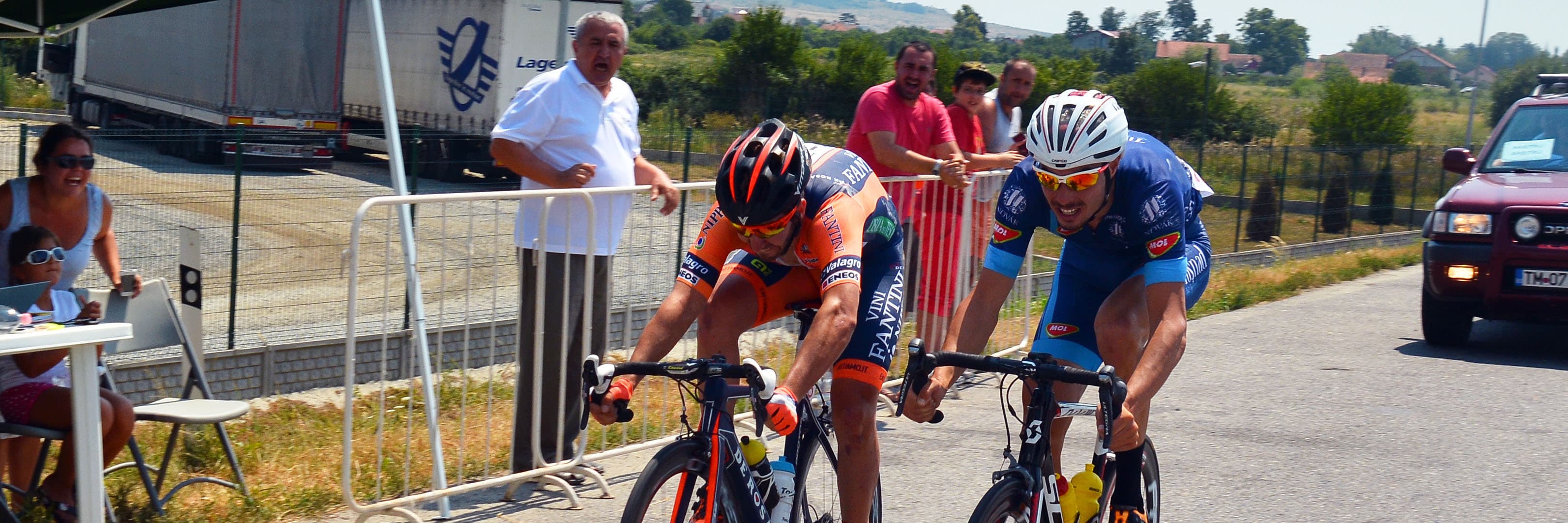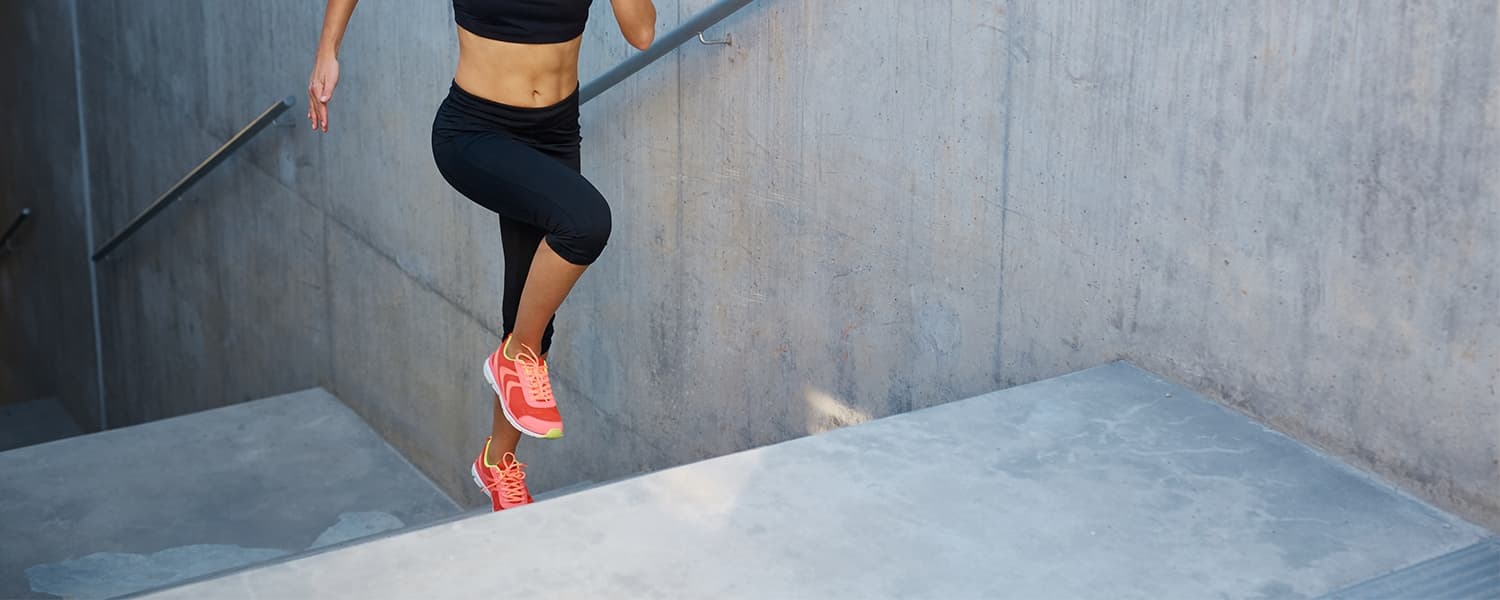
The American College of Sport's Medicine reports that muscular performance deteriorates at a rate of about 5% per decade. This accumulates to a 30-40% loss of functional strength over an adult lifespan. Soon, these people will have difficulty climbing a flight of stairs, walking, or even simply standing up from a chair. Seems like a pretty bleak future, doesn’t it? Don’t worry—there’s still hope! Strength training can keep your muscle loss at bay.
The University of Michigan recently published a study that discovered some great news for aging adults.They studied a group of people for about 20 weeks, and found that with progressive resistance training, the average subject gained 2.42 pounds of lean muscle and increased their overall strength by about 30%!
Now, I’m not saying that every 50-year-old should become a bodybuilder. First, check with your doctor, then start out slow doing some simple bodyweight exercises, such as squats, modified push-ups, and lying hip bridges. You could even start out with some simplified tai chi or yoga, which will help you with flexibility, as well as strength.
The key is to gradually increase your weight or reps, but be sure to keep within your limits. For example, if you’re suffering from osteoporosis or have a heart condition, you’ll need to be more wary of your level of exercise. However, that’s not an excuse to not move at all, since your health problems will most likely increase if you remain sedentary.
So what if you’re under 50? Does that mean you should ignore strength training until then? Heavens, no. The more muscle you’re able to build, even in your 30s and 40s, will affect how strong you are later. Even 2 days a week can make a huge difference. If you’re just starting out, or you’re not quite sure how to begin, engage a fitness trainer. Some are specialized in working with older people, so if you’re concerned about your health problems, there are experts out there who can help you do the exercises that are perfect for your age, weight, and level of health.
I’m going to give you a personal example of how much strength training and staying active can affect your health in old age. My grandparents on my father’s side, though divorced, had the same habits: watch television, eat fast food, and move as little as possible. My grandmother had several strokes before the age of 60. Although she recovered slowly from most of them, she refused to exercise and change her habits. She passed away in her early 70s. My grandfather, who swore that whiskey and jalapeños could cure anything, also loved sitting in front of the television, and rarely went out at all. He also passed away in his early 70s, after suffering from Alzheimer's (and forgetting that he was divorced from my grandmother and had been for 40 years. It was sweet, but sad).
On the other hand, my mother’s parents, who are in their late 80s, go on a walk every single day, and my grandfather lifts weights every day. (My grandmother actually catches my grandfather flexing in the mirror sometimes—how adorable is that?!) They eat from their fresh garden, which they tend to themselves, and my grandfather still mows the lawn and shovels snow. They’ve both beaten brief bouts of cancer in the past few years, and they’re still going strong!
You might think that genetics have something to do with it, or it might just be pure chance. But I’ve seen, first-hand, the difference in their lifestyles. So every time I’m binge-watching on Netflix, I try to make up for it by doing something active, just in case.
So I’d encourage you, whether you’re 30 or 90, to add strength training (with a little bit of cardio) to your weekly habits, and build your muscles up healthy and strong!
~J. Rebecca Sanders
WARNING: This post is not intended to replace the advice of a medical professional. The above information should not be used to diagnose, treat, or prevent any disease or medical condition. Please consult your doctor before making any changes to your diet, sleep methods, daily activity, or fitness routine. iFit assumes no responsibility for any personal injury or damage sustained by any recommendations, opinions, or advice given in this article.
You might also like

A Cyclist’s Guide to Hill Training
Six tips to help you become the greatest climber possible. Pay attention to your RPMs. When you maintain a higher cadence, it means you’re relying heavily on your cardiopulmonary system, or in other words, your heart and lungs. When you drop to a lower cadence and maintain the same power output, you are then relying predominantly on your muscular system, which fatigues faster and takes longer to recover. Your muscular system can take 2–3 days to fully recover, whereas your cardiopulmonary system only takes a few minutes. So the more heavily you can rely on your heart and lungs, the better. Try starting at a slightly easier gear than normal and ramp up your RPMs right as you hit the hill. Most likely your cadence will drop while climbing, but try to stay at a moderate rate. Take it back a notch. You can get in trouble quick if you break through the anaerobic threshold or remain in the anaerobic energy system too long. A good way to monitor this is with your breathing. If you feel like your lungs can’t keep up with you, then back off a bit and see if that helps. You are only able to maintain anaerobic activity for about 2 minutes. Once you push past that point, your bloodstream is usually so full of lactate that your muscles will no longer feel like they are operating correctly. Your legs will stop doing what you tell them to do, accompanied by that burning feeling you get during long sprint intervals. So make sure that if you break into anaerobic activity you don’t stay there too long, or it might be the end of your ride. Listen to your body. The way you feel can sometimes be a better indicator of what you are doing than your power meter. Many different variables can affect your power output, so don’t risk the rest of your ride by pushing your body too hard to get your watts to “where they should be”. One of the biggest factors in watt production is actually core temperature. If your core temperature rises too much, peak watt output can drop by upwards of 30%. So listen to your body and don’t overdo it. Throw in surges. Riding at a steady state is great for when you’re in a pack flying down a straightaway, but when it comes to hills, don’t just climb consistently. If you want to drop other riders as you climb, throw in little bursts of speed and increase your cadence by about 10 RPMs for 20 seconds at a time. Then throw in one last burst of speed, particularly near the crest of the hill, since most riders slow down just as the hill levels out. Surges not only help build your aerobic threshold, but they can help you make some game-changing moves on the hills. Train with different hill lengths and intensities. Just because you have a favorite hill to climb doesn’t necessarily mean that all others are inferior. Do yourself a favor and mix in a variety of different grades and lengths of hills. Try training one day with short, intense bursts of speed up steep hills that take 5 minutes or less. On another day, switch to longer hills, where you focus on riding at a consistent, steady pace for many miles. During those shorter hill sprints, you may be tempted to get out of the saddle. But remember, this can cause fatigue faster, so save standing up for the steepest parts of the climb only and not for sustained periods of time. Mixing up your training can be incredibly beneficial, even if your event has more of one type of hill. It will help you avoid getting stuck in a training rut of doing the same thing over and over. Work on improving your power to weight ratio. Every cyclist knows that power to weight is the most important ratio in cycling. Lighter cyclists are often the best climbers because they can put out a relatively small number of watts to climb the same hill at the same rate as a larger cyclist. Dropping excess weight is huge in cycling, particularly in hill climbing. In physics, work is simply defined as “work = force x distance”. When you have so much more force to overcome (your weight as well as gravity), being lighter is definitely an advantage. If you attempt to drop weight, be sure that you don’t sacrifice your muscle mass. This could drop your power output, which would be counterproductive. For men, generally between 3–19 percent body fat is considered healthy, and for women it’s usually 12–29 percent. If you have access to getting your body fat checked, that can help you to know what kind of weight loss is manageable without losing muscle mass. If you are looking to compete at an elite level, aim for a body fat percentage in the lower end of that range. For example, a male rider wants to drop weight. He weighs 190 pounds and has 22 percent body fat. He wants to drop to 10 percent body fat for racing season. He has 41.8 pounds of fat on his body, which means he has 148.2 pounds of fat-free mass on his body. Calculation: weight x body fat / 100 = total fat mass 190 x 22 / 100 = 41.8 pounds weight – total fat mass = fat-free mass 190 – 41.8 = 148.2 pounds Calculation: 100 – goal body fat / 100 = goal lean body % 100 – 10 / 100 = .9 fat-free mass / goal lean body % = ideal weight 148.2 / .9 = 164.6 pounds Fat-free mass is the number we don’t want to see drop. So to maintain his fat-free mass at 10 percent body fat, the male rider would want to weigh no less than 164.6 pounds after dropping weight. Becca Capell iFit Head Trainer WARNING: This post is not intended to replace the advice of a medical professional. The above information should not be used to diagnose, treat, or prevent any disease or medical condition. Please consult your doctor before making any changes to your diet, sleep methods, daily activity, or fitness routine. iFit assumes no responsibility for any personal injury or damage sustained by any recommendations, opinions, or advice given in this article Suggested Content Hill Climbing Gear up, and get ready to start climbing like a pro. These 10 workouts will maximize your climbing potential in less than an hour. Whether you're looking for long sustained hills, or short hill sprints, this is the program for you. Just press start to begin the climb of your life. View Details
June 16, 2015

The Rules of Proper Progression
Increase your training in a smart, safe way. The rule is a simple one: increase your training by 10 percent per week. That’s it. Well, I guess there’s a little more to it than that, but the 10 percent progression rule is where we’re going to start. Let’s use running as an example: Sarah currently runs about 15 miles per week and she just signed up for a marathon this fall, so she needs to start training. She wants to bump up her mileage, but she doesn’t want to get injured or suffer from the “too much, too soon” syndrome. Here is what her plan will look like: Week 1: 15 miles Week 2: 16.5 miles Week 3: 18.2 miles Week 4: 20 miles Week 5: 22 miles Week 6: 24.2 miles Week 7: 26.6 miles Week 8: 29.3 miles Week 9: 32.2 miles Week 10: 35.4 miles Week 11: 39 miles Week 12: 42.8 miles Within three months, Sarah can nearly triple her current weekly mileage, and with a much lower chance of injury. It may seem that you’re increasing mileage at a painfully slow rate, but 10 percent progression is a great place to start, and the miles add up fast. As your mileage increases, allow the majority of the increase to come from one long run during the week, instead of spread throughout all runs that week. At some point, you may also need to increase the frequency of activity, and add in another day of workout. Let’s use Sarah as an example again: Week 1: Sarah may run 4 days a week, with run lengths of 3,4,3, and 5 miles. Week 6: Sarah may run 5 days a week, with runs lengths of 4,3,6,3, and 8 miles. Week 12: Sarah may run 6 days a week, with run lengths of 7,5,8,6,5, and 12 miles. The same principle can be applied to strength training as well. Weight x Reps will give you your total workload. Only increase your total workload by 10% per week to start. And don’t forget that this is always weekly totals. Obviously upper body workouts will yield a lower total workload than lower body workouts due to the nature of the body. So add up all weights and reps, then multiply by 1.1 to get a 10% increase for the following week. With any fitness or training program, be sure to also listen to your body and pay attention to any warning signals. Stress fractures and shin splints are both very common overuse injuries associated with road running especially. If you are experiencing pain or symptoms of these conditions, it might be good to drop down to 5 percent progression, or just stay at one mileage for several weeks to allow yourself more time to acclimate to the higher workload. Regardless of what you are training for, remember to always train smart. Becca Capell iFit Head Trainer WARNING: This post is not intended to replace the advice of a medical professional. The above information should not be used to diagnose, treat, or prevent any disease or medical condition. Please consult your doctor before making any changes to your diet, sleep methods, daily activity, or fitness routine. iFit assumes no responsibility for any personal injury or damage sustained by any recommendations, opinions, or advice given in this article
July 6, 2015

3 Ways Your Body Fuels Itself
Your body is incredibly smart. Whether you’re lifting weights or running a marathon, your body has to figure out a way to keep itself fueled and moving in the most effective way. The key to this fueling process is the use of different energy systems. As you train, try your best to work on all three systems discussed below for maximal results. 1. Creatine Phosphate System The first one is the creatine phosphate system, which is used during short bursts of energy where movements only last 10 seconds or less. This system doesn’t use oxygen to replenish your energy stores in order to produce more energy at a faster rate. A great example is a deadlift—it requires a huge amount of energy, but it only lasts a few seconds. 2. Anaerobic Lactic System The anaerobic lactic system takes a little more time than the creatine phosphate system, with movements lasting anywhere from 30 seconds to 2 minutes. This system also produces lactic acid. A perfect example is HIIT, or High Intensity Interval Training. It’s short and sweet, but you definitely feel the burn. If you’re new to HIIT, try this workout: do jumping lunges for a minute, rest for 30 seconds, then do burpees for a minute. Repeat the cycle for 15 minutes. It’ll get your muscles working and your heart rate up to improve your cardiovascular health—a win-win situation! 3. Aerobic System The third system, known as your aerobic system, is most commonly referred to as cardio. While the term “aerobic” definitely takes me back to the ‘80s, there’s a lot more to it than just leg warmers and oversized bangs—it includes the most common form of cardio: running. Aerobic cardio lasts longer than 3 minutes and uses oxygen. It can be anything from hiking to running a marathon. The great thing is, your health will improve, regardless of what energy system your body is using. You’ll reduce the risk of heart disease, improve your blood cholesterol, increase your heart function, and help your muscle mass grow. So whether you’re a gym junkie or you just want to be healthy, exercise should become a vital part of your daily routine. What’s your favorite kind of workout and why? Tell us in the comments below! Hannah Mackintosh WARNING: This post is not intended to replace the advice of a medical professional. The above information should not be used to diagnose, treat, or prevent any disease or medical condition. Please consult your doctor before making any changes to your diet, sleep methods, daily activity, or fitness routine. iFit assumes no responsibility for any personal injury or damage sustained by any recommendations, opinions, or advice given in this article.
September 1, 2015